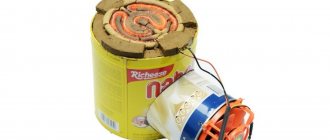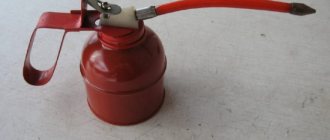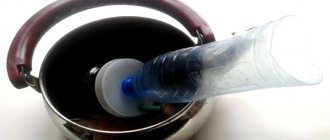HTSChemistry and experiments / Homemade products Magnetic fluid has recently become more popular in online stores. Children love to play with it, although adults also sometimes like to play around with it. That is why we decided to devote this review to making magnetic fluid at home with our own hands. We recommend starting, according to tradition, by watching a video from the author of the idea. What do we need: - vegetable oil; - iron powder; - container - magnets. According to the author of the idea, powder iron can be obtained using a file and a piece of iron. The first step is to pour the iron powder into a container. It is worth noting that the more powder you have, the better, since the properties of the magnetic fluid are fully manifested in large quantities. After this, you need to add just a little vegetable oil. Mix everything thoroughly. It is better to mix with a wooden spoon or a barbecue skewer. After one and a half to two minutes of stirring you will get your magnetic liquid. Note that when using you need to be careful and do not bring the magnet directly to the liquid, as it will stick and you will no longer be able to remove it from the magnet . Therefore, it is recommended to do this through paper, plastic or something else.
Delivery of new homemade products to the post office
Receive a selection of new homemade products by email. No spam, only useful ideas!
*By filling out the form you agree to the processing of personal data
Become the author of the site, publish your own articles, descriptions of homemade products and pay for the text. Read more here.
The theory is this: modern laser printers contain the mineral magnetite (Fe3O4). It is needed so that the paint particles stick to the paper. This mineral reacts to magnetic fields and is thus well suited for our experiment.
The first method of obtaining magnetic fluid:
Almost anyone can make a liquid that reacts to a magnetic field with their own hands - without any reagents and in just a few minutes . Of course, its quality is significantly worse than that obtained chemically. In particular, the consistency of the product is such that it can rather be called not a “liquid”, but a “slurry”. And the deposition time of magnetic particles is quite short - usually from several seconds to several minutes. But no chemistry or exotic technologies, just sifting and mixing. In order to make “magnetic slurry”, you just need to collect the required amount of small steel filings . The finer the better, so the most suitable is the steel dust remaining after working with a grinder or sharpener.
The dust is collected with a magnet (not too strong - not so much to prevent large residual magnetization, but so that the iron filings do not tend to it so intensely and carry less non-magnetic dust with them).
Then, to filter out the dirt and large fractions, it can be sifted through a cloth on a newspaper . The denser the fabric, the finer the sifted dust will be, but the longer you will have to shake the bag.
Let me emphasize once again - the steel particles should be as small as possible. To obtain fine steel dust, use a fine-grained (finishing) grinding wheel. As a guide, we can offer the following: when viewed with the naked eye, it is impossible to determine the shape of dust particles; on white paper they look like tiny dots. If the shape of the sawdust is clearly visible (with normal vision this usually corresponds to sizes of 0.1-0.3 mm or more), then such sawdust is too large, they will settle very quickly and will be practically motionless!
Figure No. 1 - Iron filings and magnet
The selected steel dust is filled with a liquid that well wets the metal. This can be ordinary water - preferably saturated with surfactants, that is, soap or other detergent (foaming here is harmful, so it should be as little as possible!).
But! To avoid rapid corrosion of iron dust particles, which can simply “eat” them in a few days, it is better to use liquid machine oil for steel . Household stuff is quite suitable - something that is used to lubricate sewing machines.
- Operating instructions for the electronic cigarette eGo-C - 2012 in Russian! — original text by Joyetech
The concentration of steel dust in the liquid should, on the one hand, not be too high, so that the liquid does not become too thick and viscous, and on the other hand, not too low, otherwise the movement of magnetic particles will not be able to carry with it any noticeable volume of liquid. It is selected experimentally by gradually adding sawdust to the liquid, thoroughly mixing and checking with a magnet . It is better to obtain a slight excess of the base fluid than its deficiency, since in the latter case the mobility of the resulting substance decreases very noticeably.
The specific value of the critical magnetic field strength depends both on the magnetic properties of the metal used and on the wetting force of the metal with the base liquid or surfactant, as well as on the temperature of the liquid and the size of the metal particles. When the magnetic field is removed, the mobility of the liquid will be restored if the residual magnetization is not too large.
Obtaining a stable ferromagnetic fluid
Currently, technical devices in which magnetic fluids act as a working fluid are widely used. However, the problem of instability of such substances remains relevant, and therefore work has been carried out to create magnetite magnetic fluid.
What is ferromagnetic fluid?
Ferrofluid is a liquid disperse system, a colloidal solution with solid ferro- or ferrimagnetic particles dispersed in it. To prevent coagulation, surfactants are introduced into the liquid base, which form protective adsorption layers on the magnetic particles, thereby preventing the separation of the liquid and solid phases. Magnetization occurs due to an external magnetic field.
Rice. 1. Adsorption layers of surfactants on the surface of particles
The goal of the work was to find a better way to make ferrofluid than previously known. Liquid magnets are not used in technology as widely as they could be (later you will understand how wide the range of their applications is), due to their instability. The objective of the study was to select conditions to find a way to eliminate this drawback and ensure optimal density and magnetization. For this purpose, the best base and stabilizer were selected, their ratio was determined, and the conditions for the ferrofluid preparation process were optimized.
The synthesis of magnetic fluid occurred in 2 stages: precipitation of magnetite, the choice of which is due to its most frequent use in technology, and its dispersion into the base fluid. Let's look at each stage in more detail.
The deposition of magnetite took place using the condensation-chemical method, since it allows one to achieve the smallest sizes of the resulting particles, is cheap and technologically advanced [1, p.53]. Salts of ferrous and ferric iron were dissolved in water, the solutions were heated until the sediment completely disappeared, passed through paper filters to separate mechanical impurities, and then precipitated with a 10% ammonia solution. The mass of required salts was calculated using the equation:
2 FeCl3 + FeCl2 + 8 NH3 + 4 H2O = Fe3O4 + 8 NH4Cl.
The resulting magnetite (Fe3O4) was washed several times and decanted to pH=9. At the sedimentation stage, some of the samples were subjected to centrifugation on a laboratory centrifuge OP-8U at 2000 rpm to separate water from sediment. Water was also separated under reduced pressure using a Schott filter, a Buchner funnel, and paper filters. It was discovered that the smallest particles of magnetite, when filtered under vacuum, leaked through the filter paper.
The next stage, dispersing the resulting magnetite into the base liquid, was carried out in two ways: heating in a water bath or shaking. Each method has advantages and disadvantages: for example, heating in a water bath requires strict temperature control, and shaking, which does not have this disadvantage, is bad in that peptization is not easy with all liquids. At this stage, it was possible to vary the properties of the resulting ferrofluid by changing the components and their combinations, as well as the ratio.
Glycerin, octane, gasoline, motor oil, I-20 oil (industrial, distillate), polyvinyl alcohol, polymethylsiloxane in various combinations with surfactants - sebacic, oleic acids, sodium oleate - were tested as carrier liquids. The disadvantage of ferrofluid prepared in octane is the rapid evaporation of the base liquid, which results in thickening of the liquid. The ferrofluid based on polyvinyl alcohol froze upon cooling, since the polyvinyl alcohol settled; glycerin was added to prevent this, but the desired result could not be achieved, since the mobility dropped sharply. The remaining bases also turned out to be inconvenient to use, with the exception of I-20, which provides optimal magnetization and viscosity, and polymethylsiloxane, which gave the best result. Silicone oil is a stable, inert base that is not corrosive to iron particles [2, p.38]. So, the optimal bases turned out to be octane, I-20 oil and polymethylsiloxane, and oleic acid was used as a surfactant.
In the course of the work, conditions were created for the production of small Fe3O4 particles of colloidal size (5–10 nm), and the ratio of the liquid base, magnetite and surfactant was determined for the preparation of the most stable concentrate (70% magnetite, 20% base and 10% surfactant by weight) , the peptization process has been worked out. The advantages and disadvantages of bases and surfactants and their compatibility were also identified. Attention is focused on the influence of the base on the properties of the ferromagnetic fluid, for example, when heated, some oils expand, and, therefore, the number of particles in a unit volume decreases, which leads to a decrease in magnetization.
In the future, it is planned to analyze the stabilizing properties of surfactants and polymers for highly dispersed metal particles in order to simplify the selection of surfactants for each specific base. It is expected to test more bases (transformer, capacitor, turbine oils, organofluorine base) and surfactants (anionic, cationic, non-ionic) and prepare a magnetic fluid with other (non-magnetite) colloidal particles, for example, MnZn and NiZn, cobalt compounds.
The practical applications of ferromagnetic liquids are great: from money printing to medicine and rocket science. They can be used for transporting drugs to diseased organs [3, p.116], supplying fuel from tanks to the engine during non-contact control, enriching rocks, and also for collecting spilled oil.
Thus, thanks to various variations of components, prospects are opening up for the preparation of liquids with certain magnetic properties, which significantly expands the possibilities of their use.
Literature:
- Rosenzweig R. Ferrohydrodynamics (1989).
- Fertman V. E. Magnetic fluids (1988).
- Taketomi S., Chikazumi S. Magnetic fluids (1993).
- Brook E. T., Fer in a glass (1983).
- Patricia Berger, Nicholas B. Adelman, Katie J. Beckman, Dean J. Campbell, Arthur B. Ellis, George C. Lisensky Preparation and Properties of an Aqueous Ferrofluid (1999).
- Senatskaya I., Bayburtsky F. Magnetic fluids (2002).
DIY ferromagnetic liquid with a laser printer cartridge
Ferromagnetic liquids are colloidal systems consisting of ferromagnetic or ferrimagnetic nanometer-sized particles suspended in a carrier liquid, which is usually an organic solvent or water. To ensure the stability of such a liquid, ferromagnetic particles are associated with a surfactant, which forms a protective shell around the particles and prevents them from sticking together due to van der Waals or magnetic forces.
What is ferrofluid?
We are talking about a ferrofluid - a colloidal system consisting of water or other organic solvent containing tiny particles of magnetite, and any material that contains iron. Their sizes are so small that it’s even hard to imagine: they are tens of times thinner than a human hair! Such microscopic size indicators allow them to be evenly distributed in the solvent using thermal movement.
For the time being, as long as there is no external influence, the liquid is calm, resembling a mirror. But as soon as you bring a directed magnetic field to this “mirror”, it comes to life, showing the viewer amazing three-dimensional pictures: magical flowers bloom, moving figures grow on the surface, changing under the influence of the field.
Depending on the strength and direction of the magnetic field, the pictures change before our eyes - from light, barely noticeable ripples appearing on the surface of the liquid, through needles and peaks that change sharpness and slope and grow into flowers and trees.
The ability to create color paintings using backlighting, truly mesmerizing to the observer, reveals an unknown world to him.
Unfortunately, metal particles, although called ferromagnetic, are not ferromagnetic in the full sense, since they cannot retain their resulting shape after the disappearance of the magnetic field. Because they do not have their own magnetization. In this regard, the use of this discovery, which, by the way, is not entirely new - it was made by the American Rosenzweig in the middle of the last century, has not found wide application.
Greetings to all! There are things that, in general, are not very useful, but at the same time they can pass the time, amuse or distract a person
In the category of such things I would include the most useless thing - a box from which a kitten's paw crawls out and presses a button. But today we are not talking about such a thing, but about a thing that will absorb you for a while.
In today's review I will show and talk about ferromagnetic liquid in a bottle. Delivery of the parcel took 2 weeks by China Post. The parcel itself was small in size - the box with the liquid was packed in a cardboard box + tape. Nothing was damaged during transportation. Opening the box you can see a jar and four magnets, two with convenient finger holders and two without mounts. The magnets are quite strong, connecting them to each other - you need to be careful not to pinch your fingers. A little description and characteristics:
— A flask/jar with a liquid containing a ferromagnetic substance. — Flask material: glass, sealed neck. — Bottle height: 9cm, width: 5cm, weight: 183 grams. Let's take a closer look at this magnetic miracle. To understand how this thing works, just bring a magnet to the flask. =) As soon as the magnet and the liquid come into contact through the glass, the black liquid inside the flask tends to the magnet and eventually takes the shape of a hedgehog. Using two magnets, you can divide the magnetic liquid into 2 independent parts. By shaking the flask, you can see how the black liquid splits into small balls.
Conclusion:
The thing is funny and can really attract attention.
I won’t say anything about usefulness; it’s a useless thing, but interesting in its own way. So for the sake of variety or something new, it’s quite possible to buy. My copy costs $17 and is a copy of the original product from kickstarter. The original costs from $30 to $50. Unboxing, review and first impressions in the video: Thank you all for watching!
I hope my review was useful to someone. If you have any questions regarding this product, write in the comments below and I will try to answer everyone! For more interesting reviews of electronics and radio-controlled models, see my profile: mysku.ru/my/djkrava Video reviews and unpackings of these and other interesting products on my channel: www.youtube.com/
The product was provided for writing a review by the store. The review was published in accordance with clause 18 of the Site Rules.
Source











